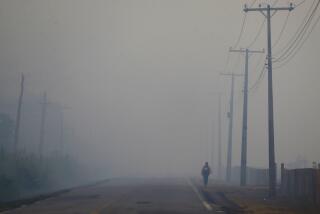Brazil’s Global Forests
- Share via
Brazilians often compare their country to the United States at the turn of the century: a large territory, blessed with natural resources, just waiting to be exploited by an eager and fast-growing population. They expect Brazil to be as rich as the United States sometime in the 21st Century, which certainly seems likely.
But one must hope that Brazilians will not look back on the development of their nation with as much sorrow as pride. For, like many North Americans in the 19th Century, Brazilians have often overlooked the environment in their rush to modernity. That may have begun to change last week, when Brazilian President Jose Sarney responded to growing international criticism over destruction of the Amazon rain forest by announcing a series of steps to protect the region’s fragile environment from uncontrolled exploitation.
Since 1960, hundreds of thousands of settlers have moved from Brazil’s densely settled coast into its sprawling interior. Like North Americans who moved west in the 19th Century, Brazil’s pioneers include both natives and recent immigrants. They pursue jobs similar to those that drew the frontiersmen of this country, as cattlemen, farmers, miners and loggers. Like their U.S. counterparts, they push indigenous peoples aside as they bring their civilization to the frontier. They are not always gentle in doing so, and they have technology on their side to speed up settlement. As U.S. pioneers used railroads, Brazilians use aircraft and highways to expand the frontier.
But in seeking land and wealth in the Amazon, Brazilians have been displacing unique animal and insect species that the entire world would miss if they were to disappear. And continued destruction of the region’s forests, which is proceeding at almost breathtaking pace, poses a serious global threat. So the world has a stake in making sure Brazil exploits its resources carefully and wisely.
Just how big a stake was made starkly clear this summer, when Brazilian and U.S. scientists concluded that the burning of trees in the Amazon contributes almost as much to global warming--the so-called Greenhouse Effect--as the burning of all fossil fuels. They find that man-made fires in the Amazon basin, where cattlemen and farmers use flame to clear the way for grazing land and crops, contributed more than 500 million tons of carbon and 44 million tons of carbon monoxide to the world’s atmosphere in 1987 alone! There were similarly awesome amounts of methane, ozone, nitrogen oxide and other substances produced by the Brazilian burning. And beyond the damage done to the atmosphere by smoke from these fires, there is more--as trees vanish, so does the process of converting carbon dioxide into oxygen.
Some Brazilians defend the policy based on the wealth and opportunities created by development in the interior, no small consideration when so many of them are poor and malnourished. But the fact remains that neither the Brazilian government nor the international development agencies that provide the loans that help the country grow have done enough to control and channel development. Sarney, in his speech on the environment, conceded as much. He announced an end to tax breaks, subsidies and other economic incentives for development projects that damage the environment. He also pledged to increase government support for Brazil’s undermanned and overworked environmental protection agencies, including the Forestry Agency, which does not even have enough rangers to prevent deliberately set forest fires in Brazil’s national parks and preserves. In his speech, Sarney said the “red light” that alerted him to the danger the Amazon faces from man was a disclosure by Brazilian scientists that they found more than 6,000 man-made fires burning in the Amazon on a single day recently.
It would be hypocritical, of course, for we in the United States to demand that Brazilians drastically change their development path in order to satisfy our relatively recent concern for the environment. So the pressure this country and other developed nations apply to help Brazilians avoid our past mistakes will have to be more subtle and indirect.
The U.S. government will have to work through international agencies like the World Bank and the Inter-American Development Bank to make sure that when they lend money for dams and highways in the Amazon (as well as in other rain forests of South and Central America) that they take environmental concerns into account. And private U.S. donors can help organizations like the World Wildlife Fund, which is buying up debt in countries like Brazil and Costa Rica, converting the dollars to local currency, and then using it to buy forest land for nature preserves. Each step is a small one, but like the thousands of fires that are burning up the Amazon, it is the cumulative effect that will make the difference.
More to Read
Sign up for Essential California
The most important California stories and recommendations in your inbox every morning.
You may occasionally receive promotional content from the Los Angeles Times.













